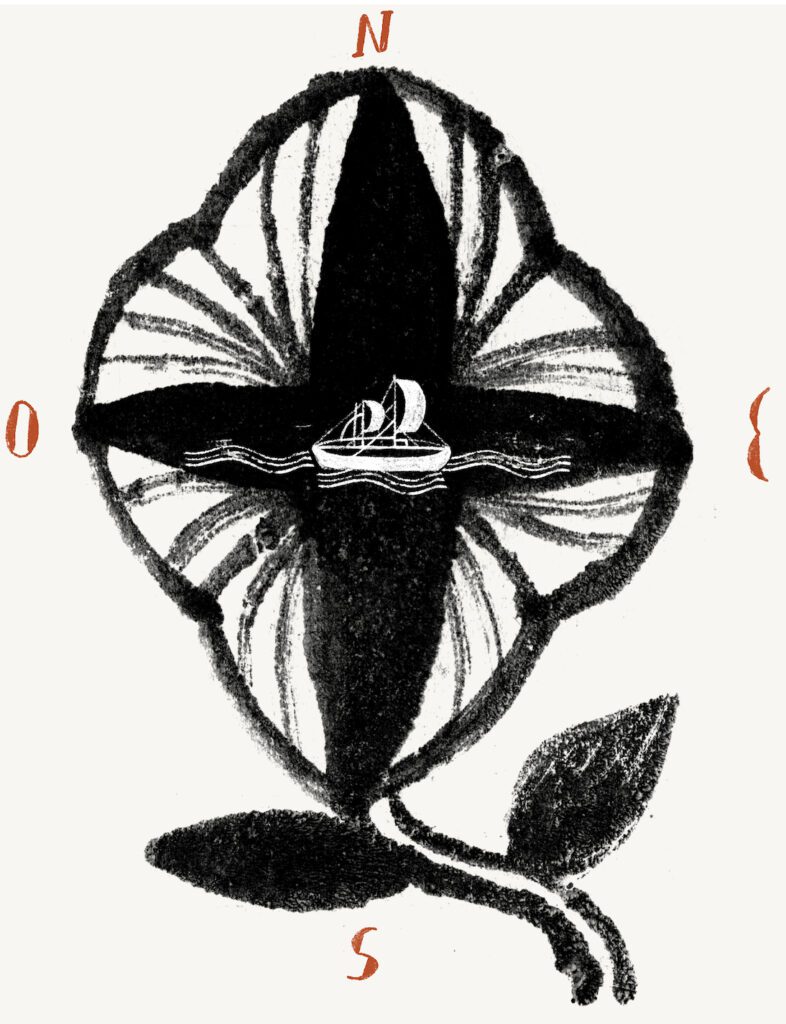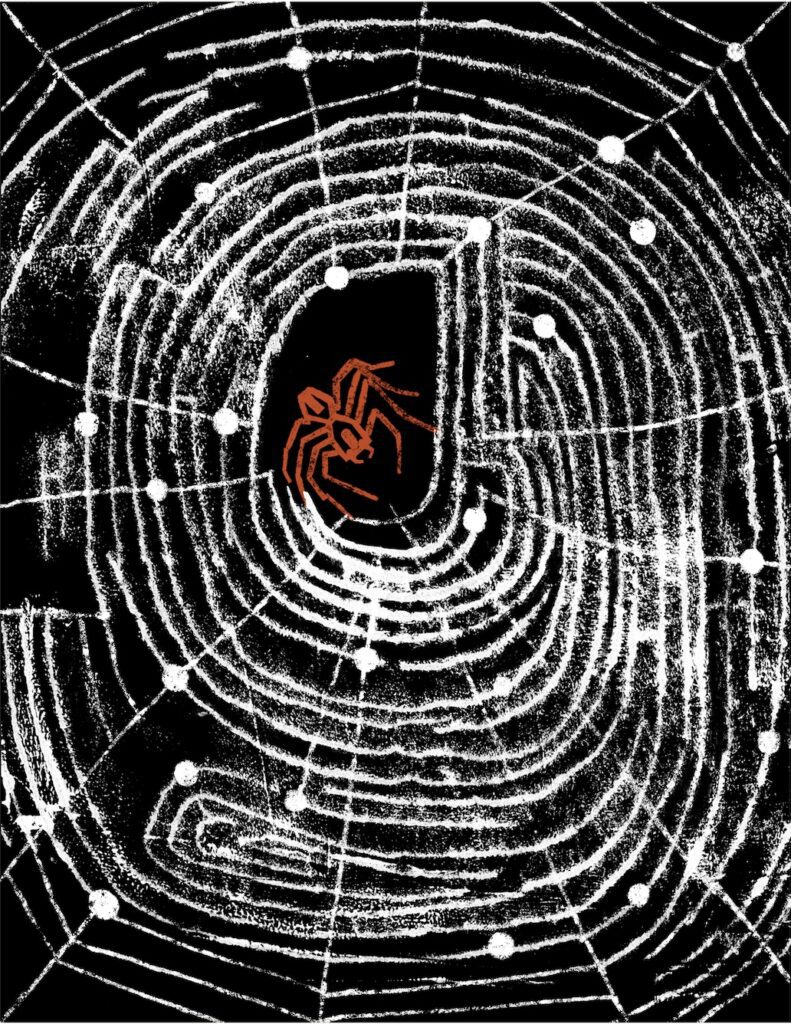* The space that surrounds is a collection of notes written about space through an expanded field of related topics and interests. The notes have emerged from conversations between Frida Robles and Lasse Mouritzen and were further accompanied and interpreted by illustrator Armando Fonseca.
All of us live in different countries. We have found interest in spatial logics, agendas and deviations on various scales, from everyday life to urban vegetation and contemporary dance. With these notes, we do not expect to make a certain asseveration on space but rather use it as a starting point, from where to think together in the form of vignettes, quotes, lines of thought and associations that we share with you.
One direction leads us to our house, another to our friend’s house, there is a tree in between and cars in movement. Sailors and marines have been guiding themselves for centuries with the usage of a compass that can let them know that the north is where the arrow is pointing. When there are no starting points, no references when one departs; when the surroundings are either seemingly identical or unfixable; one feels lost. Like the movement of the myriad of ocean waves, one after the other, all looking similar to the next, and the wind that moves them and the tremor of the ocean inside them.
Beware: surviving on this boat is by no means about ‘controlling’ or ‘mastering’ a surrounding ‘nature‘
– Nicolaj Schultz

A sudden loss of memory can create a whole world of estrangement: Where am I now? How do I exist in this place? Who are these people whose faces I do not recognize?
We continue our life in spaces that are apprehendable, that ‘make sense’ to us. Those we have memorized, internalized and structured. Most rooms are organized similarly, there is a bed or a place to rest, there are doors and passages, chairs or places to sit, there are windows, the surfaces we walk on are flat or, at least, obstacle-free. We inhabit our spaces by attaching memories and narratives to organize them, to navigate through them. “It is not simply that we act in space; spatial relations between subjects and others are produced through actions, which make some things available to the reached.” (Sarah Ahmed)
In everyone of us there is a sensorial connection to territories, to spaces. Touch, smell, sight, we savour the different atmospheres that the combination of spaces, objects and bodies create. Edouard Glissant writes about the trembling of the world; the palpitating poeisis that keeps everything always in movement – in existence. “Unity is sub-marine” he quotes Barbadian poet Kamau Brathwaite as he summits for the continuum of movement and waves that keeps us all together; the complex web of the infinitesimal apparent and ghostly relations that allow for the continuation of the world.
I suppose it is out of laziness that the world is the same day after day. Today it seemed to want to change. And then anything, anything could happen
– Jean-Paul Sartre
A stubborn repetition of movement in Pina Bausch’s performances expresses how emotions tie to our corporeal movements. Continuous stepping on the floor, going from one wall to the opposing one, imitating how spaces frame life. The walls orientate our emotions too. As one can imagine a prisoner staring at a wall for hours and days. Spaces (dis)orientate our feelings.
A gigantic block of ice is pushed across the streets of Mexico City until it liquifies in its entirety drawing watery lines on the pavements of the city. It is 1997. In the action ‘Sometimes Making Something Leads to Nothing’ Francis Alÿs uses space almost like a canvas, in which to express, to draw, to think. The ephymerous drawing is only effective in its context, in the hustle and bustle of that 22-million people city.

Sprouts, new leaves, blossoms and changing colors. Plants inform us of the changing seasons, of the rhythmic cycles of nature. They are still there, in the city, the plants. They serve a purpose to our urban daily life. Pacified and staged, some would say shy. Agnès Varda said that a day without seeing a tree is a waste of a day. Maybe this attraction is not only about seeing the tree as a friend or companion in the city but also as something evolving, growing; a rebel within the grid? Like those street trees whose roots grow and lift up the asphalt; crack and break it into chunks finally opening up to the sunless soil beneath our feet. “Beneath the pavement, the beach” Guy Debord wrote in his famous Society of Spectacle. Perhaps the roots breaking through the asphalt show a glimpse of the beach; of the spontaneity and possibilities of life outside the confined and striated orders?
They took all the trees. And put them in a tree museum. Then they charged the
people a dollar and half just to see them.
– Joni Michell
In Vienna, the facade and roof of the IKEA building at Westbahnhof are covered with 160 potted trees and plants. All expected to help as a natural air conditioning system, purifying the air and cooling down the surrounding space by 1,5 degrees celsius. Thus fulfilling governmental regulations concerning the allotment of vegetation in every new construction. IKEA seems to have found a way around this by converting vegetation into something moveable and smooth, easier to reconfigure and control in order to please customers and form a “healthy and pleasant environment” around consumption. Maybe the oasis is (in) the city?
When trees and plants are moved, they can experience what is called transplant shock – stress that recently transplanted shrubs or trees can experience. The shock occurs when the plant has not established a root system extensive enough to keep up with its needs and can take up to years to fully recover. What are the costs, thinking in terms of the world, when plants and trees lose their potential to interconnect, entable and relate?
A 114-year-old chestnut tree is being cut down in order to prepare the terrain and initiate the new subway city ring. It takes place on Enghave Square in Copenhagen, Denmark, 2011. It could have been anywhere. The tree housed bats in its crown and at ground level it gave shelter and shadow to people who would gather there. When the tree was cut down, the space was bulldozed. The bats and people were left to find a new place. In a workshop organized locally, the wood from the now dead chestnut tree was carved as movable urban furniture. The subheading of the local newspaper said: “The chestnut tree resurrects in the form of new urban furniture, made by the local citizens”. How are these ideas of ‘movable vegetation’ and ‘movable remains’ affecting our understanding of space? It seems that fragmenting the elements of the world into single entities which can be displaced, arranged and re-configured, is deemed more efficient, productive and, more importantly, profitable. What to say about human displacement and the politics of space that they convey?
The fish,
– Mourid Barghouti
Even in the fisherman’s net,
Still carries,
The smell of the sea.
It is November 6th, 2002 and people pass by as they normally do in the central Plaza Bolívar of Bogotá. Unexpectedly, one chair hangs from the facade of the Palace of Justice. After some time, another one. And then a couple of chairs more, together. The building gets populated by numerous hanging chairs. The work entitled November 6 and 7 by artist Doris Salcedo refers to the seize of the Palace of Justice in 1985, in which members of the leftist M-19 guerrilla group held the Supreme Court hostage. Three hundred people were taken hostage during those two days and 101 people died. Each of the chairs thrown against the facade in Salcedo’s work stand for each of the victims.
Spaces remember. They are sensorial planes beaming with emotions. A space is never without history, without layers of stories of what had happened but also of the future projections and imaginations. A space, even the most empty one, remembers. One has to feel the space one is in, to connect to the ghosts that populate it. Is it that spaces speak in a language that is codified as sensorial?

The arctic fox merges with the icy spaces of the north. Its white fur mimics the color of the snow, wandering in-between the self and the environment. By changing the fur, skin pattern, color and appearances, beings become part of the landscape or travel through it. Blurring the boundaries between the perceiving body and its milieu, singularity and space. It is a strategy to imitate nature in order to disappear from predators or to hunt.
To become like everybody else; but this, precisely, is a becoming only for one who knows how to be nobody, to no longer be anybody. To paint oneself gray on gray.
– Gilles Deleuze
According to French writer, Roger Callouis, camouflage is an act that causes disturbances in space – a deconstruction of distance between the viewer, the subject and the background. In his essay Mimicry and Legendary Psychasthenia he argues that camouflage and mimicry might not only be a strategy for escaping predators, but also an urge or a desire to become space – a possibility to be absorbed or transformed into space. Does becoming space, beyond the basic needs of surviving or hunting, hold a promosis of depersonalisation or freedom?

As the scene is described, it becomes increasingly clear that it is not being
– Inger Christensen
described but concealed
The acclaimed and criticized photographic series Intra, of Irish photographer Richard Mosse, used a discontinued aerial surveillance film called Kodak Aerochrome which was used in war to detect where camouflaged soldiers/rebels would hide. The film has the effect of portraying the vegetation in bright pink to reveal people hiding. Moose’s work presented in 2012, was aimed at bringing attention to the armed conflict in the Democratic Republic of Congo, known as the Second Congo War, which was ongoing at the time (2008-2018) and during which 5.4 million people are noted to have died and over 400,000 women to have been raped. Mosse used the metaphor and war technology of camouflage to call attention to the invisibilized conflict and the camouflaging politics of representation. The photo series perhaps let us think on how war understands territory as a space to hide, to move, to attack and to conquer.
Now what is this fear or desire of being absorbed into something else; not being able to grasp where the self stops and the surrounding space begins? In darkness, one becomes infinite; extended or even schizophrenic towards everything that this space could encompass, everything that yourself could now become. In absolute darkness, becoming a lifeform beyond oneself.
Often I sense the direction of and my distance from people or objects – in the dark, or with my eyes closed, without looking. It must be a vestige of a proximity sense, a sixth sense that’s lain dormant from long-ago times.
– Gloria Anzaldúa
